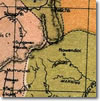
Pastoral Station entry
| Home | Browse | Search | Previous | Next |

|
Unlocking Regional Memory
Pastoral Station entry
|
|
Bengalla Station |
|
|
|
| Location: Muswellbrook, New South Wales, Australia | |
Located in the upper Hunter Valley, Bengalla station was originally comprised of several title holders, eventually, Samuel Wright became the sole owner by 1832. The name derives from Wright’s connection and affection for Ireland. Galla may have been derived from one of several Gaelic words, but probably was " hill of gall", which among other meanings was "the hill of weeping or sorrows". |
Details |
|
Bengalla Station, situated several kilometres south of the present-day town of Muswellbrook in the Hunter Valley, was first occupied as a pastoral run in 1827. Captain Samuel Wright, a celebrated soldier who had arrived in Australia in 1822, was granted the property in reward for his services at the Battle of Waterloo. Wright accumulated land around Bengalla, and within a decade the original grant of 2,500 acres had been increased to 14,000 acres. There he built a ‘stately mansion’; nevertheless, Wright continued to live in Newcastle while Bengalla itself was managed by an overseer, John Brothers. In 1846, Bengalla was leased to John Hudson Keys, manager of Henry Dumaresq’s Hunter River property St Heliers, and several years later Keys purchased the station from Captain Wright. Under JH Keys, a further 6,000 acres was added to the estate when he purchased the adjoining station of Rossgoll. During the second half of the nineteenth century, first Keys and then his son, Richard Thom, who was born at Bengalla, introduced many improvements to the property. A share system of dairy farming began as early as 1897 and at the turn of the century a centrifugal pump was installed which raised 90,000 gallons of water an hour, with wonderful results for RT Keys' much-loved gardens. Richard Thom married Emily Margarette, daughter of Captain Deloitte, of Balmain, and their son, John Hudson Keys, spent his life continuing the improvement of the lands of Bengalla by irrigation, fencing and maintaining the station's high standard dairy herd. In 1952, JH Keys died in Scotland, and his son, Richard Hudson, inherired a greatly reduced property where many of the lovely river flats had been resumed for closer settlement after World War Two. In recent years, much of the original estate has been worked for its rich coal deposits. The Bengalla Mining Company, which was established in 1996 and began operating in 1999, is today owned by Coal and Allied and produces more than 8 million tonnes of coal a year. Full Note:
|
|
|
| ||
|
Published by The Australian Science and Technology Heritage Centre, 5 April 2004 Prepared by: Acknowledgements Updated: 23 February 2010 http://www.nswera.net.au/biogs/UNE0052b.htm |